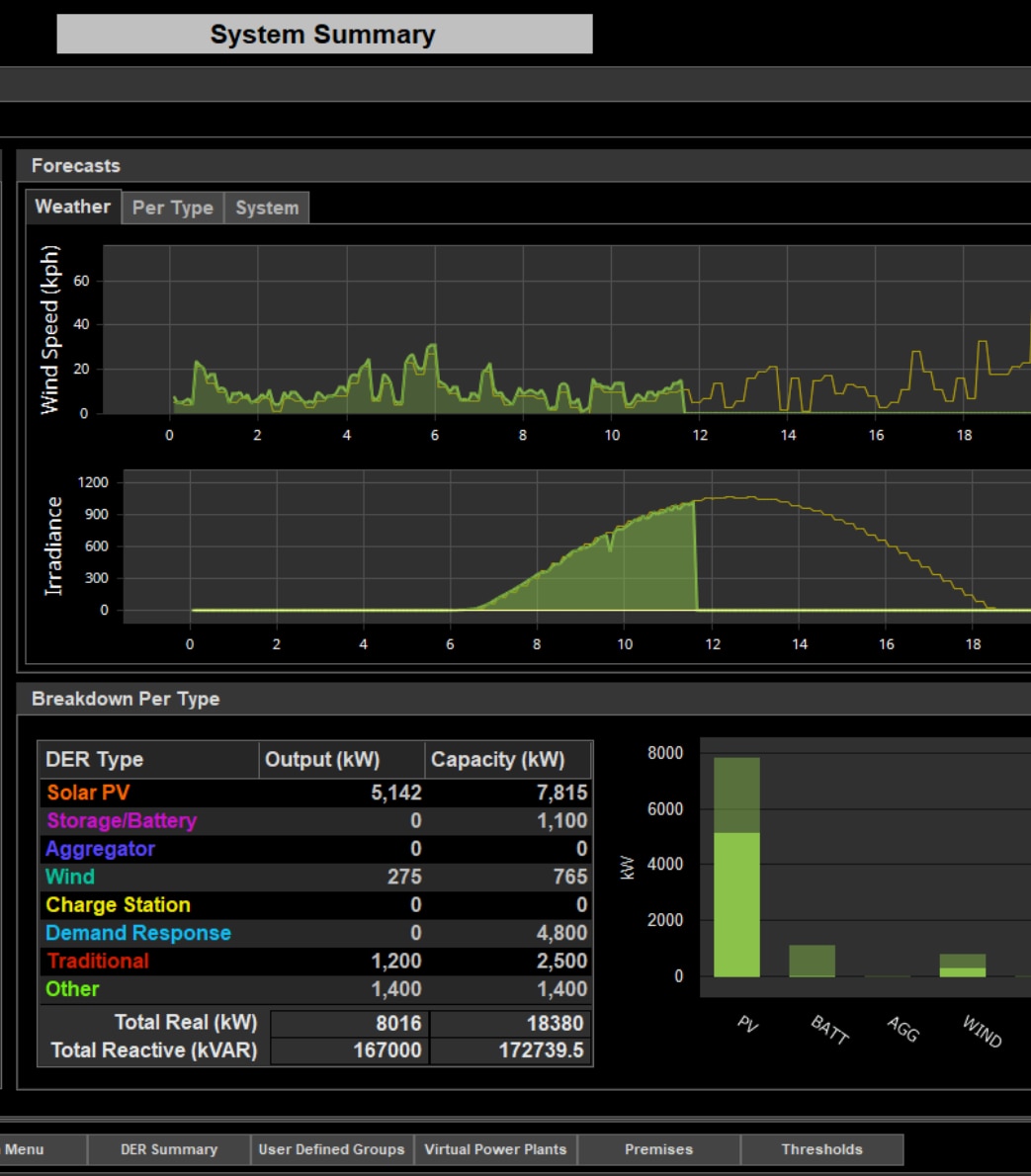It’s often described as the largest machine in the world, but even that doesn’t do justice to just how complex the electric grid really is.
For starters, there’s its sheer size – the U.S. grid serves millions of customers across thousands of miles, from high rises in downtown Manhattan to dirt-road cabins in Alaska. Producing all that power is getting more complex – where once a relatively few large, centralized coal- and natural gas-fired plants and hydroelectric dams generated power, it is today far more decentralized with millions of solar panels, wind turbines and other distributed renewable energy resources (DERs) in the mix.
That complexity isn’t limited to the generation half of the equation. As DERs like smart thermostats, rooftop solar panels and electric vehicle chargers become more ubiquitous, utilities are grappling with how to deal with them – and the vast amount of data they produce – in a more cohesive way.
At the same time, utilities are facing significant increases in power demand. Over the next decade, power demand will grow by 15 to 20 percent, and could double by 2050, according to U.S. Department of Energy (DOE) predictions.
Taken together, those issues result in utilities facing the combined challenge of delivering reliable, safe and affordable power, while also responding to increasing grid pressure driven by rapidly growing power demand and dealing with outages and other damage caused by increasingly violent storms.
It's no wonder that some are suggesting artificial intelligence (AI) as one technology to help address this urgent industry challenge.
|
|
|
A key feature of any DERMS software is to give utility operators the ability to track, understand—and in some cases—control the behavior of the thousands of DERs connected to the grid.
|
Learning from Industrial AI’s Successful Applications
For years, companies in asset-intensive industries like oil and gas or chemicals have used some form of AI to optimize their operations. This technology has become a key tool for companies seeking to increase efficiency, optimize processes and help meet carbon emission goals. Dubbed “Industrial AI,” those tools are built on a foundation of deep domain expertise and engineering fundamentals, which provide key guardrails that ensure AI operates in safe and reliable ways.
Among utilities, however, AI adoption has been slower – especially when it comes to mission-critical operating systems, like SCADA, Energy Management Systems (EMS), Advanced Distribution Management Systems (ADMS) and more. Utilities are typically reticent to adopt disruptive technology without extensive vetting, but much can be learned from the effective applications of Industrial AI in asset-intensive industries. Similar to utilities, asset-intensive industries operate mission-critical infrastructure with their own essential requirements for safety, reliability and environmental stewardship. With built-in guardrails in place, Industrial AI is becoming an increasingly beneficial tool for utilities to analyze complex grid operations, find patterns and develop efficiency improvements in automated solutions.
How Industrial AI Can Help Manage the Grid Today
For a utility, the ability to balance supply of power to demand is their most fundamental objective to ensure a reliable grid. To plan ahead, utilities must be able to forecast power demand based on past user data and renewable generation based on weather data. As renewable generation like solar and wind continue to grow, their contribution to the overall power system becomes more important to accurately forecast and manage.
Using Industrial AI tools, some companies can now accurately forecast not only renewable power generation at a localized level but also load demand by end consumers more than a month in advance. Those predictions allow companies to more precisely plan how to meet the power needs of customers and maintain a balanced electrical system to avoid outages and deliver reliable, affordable power.
Industrial AI Applications for the Near Future
One of the central reasons for the rise in using Industrial AI tools to manage the grid comes down to a single word – data.
With millions of connected devices, today’s grid is more akin to a two-way highway than the one-way road of the past, and carries not only power in both directions, but also huge amounts of data. Residential solar panels, smart thermostats, home EV chargers, battery storage and more are generating vast amounts of data.
For operators, that deluge of data can quickly become overwhelming.
Given the millions of data points pouring into control rooms, it is difficult – if not outright impossible – to fully comprehend what is happening on the grid from one moment to the next. As a result, operators can struggle to understand where and why bottlenecks may occur, or how to avoid them.
As an example, consider the grid in California. While utilities may rely on solar generation for a large portion of their electricity, that generation can dip if the skies suddenly turn cloudy. At the same time, if a number of customers in a particular area begin charging electric vehicles, that load could easily overwhelm a service transformer, leading to an outage and major incurred cost to the power utility.
With its ability to analyze and identify patterns in vast amounts of grid data, Industrial AI could help operators avoid such scenarios. While it’s not yet fully used in such mission-critical applications, Industrial AI could not only identify such patterns but provide real-time guidance to help operators make decisions that avoid potential problems before they occur.
And when those problems do occur, they often come with additional challenges. In many cases, a single incident can set off a cascade of alarms. While it can be difficult and time consuming to untangle those alerts to arrive at the root cause of a problem, Industrial AI can help. Smart alarm management can group, filter and remove “noise” allowing operators to prioritize issues with the largest impact and make faster decisions to prevent more significant issues.
Importantly, though, those decisions are ultimately made by human operators.
In the near term, keeping humans in the loop is among the key guardrail utilities have built into grid management tools to ensure AI algorithms don’t become “unleashed” and produce confusing or incorrect results. Keeping humans in the loop not only helps to ensure the health of the grid but also ensures that the final decision on what action to take is made by someone who understands how the grid operates and that those decisions align with the utility’s goals.
By ensuring operators are kept in the control loop, companies can reap the benefits of AI – the ability to process the massive amount of data coming from the grid, predict problems before they occur and respond to complex scenarios – while also delivering safe, reliable power to customers.
Embedding Industrial AI into Grid Management
As AI continues to prove itself reliable, however, its role in grid management will expand in the future.
Other applications for Industrial AI could include the ability to automate certain functions, like the dispatch of repair crews. Though typically still a manual process at many utilities, dispatch decision-making is under growing pressure as increases in extreme weather cause more outages. Using Industrial AI, utilities could more efficiently send crews where they’re needed.
|
|
|
Industrial AI could coordinate repair crew activities to maximize productivity and minimize repair time.
|
The electrical grid is incredibly dynamic, with conditions that can change from minute to minute. As grids expand and renewable generation increases, the complexity and unpredictability of the grid is increasing, which poses significant challenges for operators.
Among those challenges is congestion management on the transmission grid, which involves actively managing the flow of electricity to prevent overloading certain areas. Unfortunately for operators, congestion management can result in significant costs due to the need to re-dispatch generators. While it is possible to reduce those costs by optimizing and automating line and bus switching, the large number of variables involved can make it difficult to identify the correct sequence.
Industrial AI tools could help overcome those challenges by assisting operators in resolving congestion, leading to improved decision-making processes and enhanced operational efficiency, alleviating congestion and reducing costs.
Industrial AI could also help utilities avoid outages by allowing operators to understand the condition of transformers and other assets and using that information in decisions about power flow management and analysis.
In the future, AI will be an important component of grid management. As the energy transition progresses, the technology will play a critical role in helping to build and manage a complex grid by enabling more diverse low- and no-carbon energy sources to deliver power to more customers than ever before. With careful planning, and learnings applied from other industries operating mission-critical infrastructure, the combination of Industrial AI and digital grid management can help utilities deliver safe, reliable power to customers around the globe.



Leave A Comment